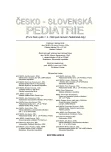Progressive Familial Intrahepatic Cholestasis
Authors:
P. Dědek
Authors‘ workplace:
Dětská klinika Fakultní nemocnice a Lékařská fakulta, Hradec Králové
přednosta prof. MUDr. M. Bayer, DrSc.
Published in:
Čes-slov Pediat 2010; 65 (4): 197-205.
Category:
Postgraduate Education
Overview
The term progressive familial intrahepatic cholestasis (PFIC) represents complex designation for a heterogeneous group of diseases developing due to mutations in genes coding canalicular proteins associated with the bile production. According to specific mutation we can distinguish 3 types of PFIC (PFIC1–3). PFIC1 and PFIC2 usually appear during the first months of the life; PFIC3 then appears much later - during the whole childhood and rarely even in adults. Phenotypic manifestations of PFIC are diverse, but the main symptoms are pruritus and jaundice.
Diagnostics is based on precise evaluation of clinical course of the disease, biochemical liver tests (normal levels of gammaglutamyltransferase in PFIC1 and PFIC2 are unique), and histological, immunohistochemical and electron microscopic examination of the liver tissue. Biliary tract imaging together with biochemical bile analysis is sometimes indicated in PFIC3. Molecular genetic examination of all three types of PFIC is also available. Conservative treatment, which consists of standard cholestasis management including ursodeoxycholic acid application, usually fails. The natural history of the disease may be influenced by biliary diversion, but most of the patients progresses to liver failure and requires liver transplantation.
Key words:
progressive familial intrahepatic cholestasis
Sources
1. Davit-Spraul A, Gonzales E, Baussan CH, et al. Progressive familial intrahepatic cholestasis. Orphanet. J. Rare Dis. 2009; 4: I.
2. Balisteri WF, Bezerra JA. Whatever happend to „neonatal hepatitis“? Clin. Liver Dis. 2006; 10: 27–53.
3. Rafeey M, Golzar A, Javadzadeh A. Cholestatic syndromes of infancy. Pak. J. Biol. Sci. 2008; 11: 1764–1767.
4. Bull LN, Carlton VE, Stricker NL, et al. Genetic and morphological findings in progressive familial intrahepatic cholestasis (Byler disease [PFIC-1] and Byler syndrome): evidence for heterogeneity. Hepatology 1997; 26: 155–164.
5. Knisely AS. Progressive familial intrahepatic cholestasis: a personal perspective. Pediatr. Dev. Pathol. 2000; 3: 113–125.
6. Alissa FT, Jaffe R, Shneider BL. Update on progressive familial intrahepatic cholestasis. J. Pediatr. Gastroenterol. Nutr. 2008; 46: 241–252.
7. Carlton VE, Pawlikowska L, Bull LN. Molecular basis of intrahepatic cholestasis. Ann. Med. 2004; 36: 606–617.
8. Harris MJ, Le Couter DG, Arias IM. Progressive familial intrahepatic cholestasis: genetic disorders of biliary transporters. J. Gastroenterol. Hepatol. 2005; 20: 807–817.
9. Tomer G, Schneider BL. Disorders of bile formation and biliary transport. Gastroenterol. Clin. N. Am. 2003; 32: 839–855.
10. Van Mill SW, Klomp LW, Bull LN, et al. FIC1 disease: a spectrum of intrahepatic cholestatic disorders. Semin. Liver Dis. 2001; 21: 535–544.
11. Stapelbroek JM, van Erpecum KJ, Klomp LW, et al. Nasobiliary drainage induces long-lasting remission in benign recurrent intrahepatic cholestasis. Hepatology 2006; 43: 51–53.
12. Strautnieks SS, Byrne JA, Pawlikowska L, et al. Severe bile salt export pump deficiency: 82 different ABCB11 mutations in 109 families. Gastroenterology 2008; 134: 1203–1214.
13. Englert C, Grabhorn E, Richter A, et al. Liver transplantation in children with progressive familial intrahepatic cholestasis. Transplantation 2007; 84: 1361–1363.
14. Wanty C, Joomye R, Van Hoorebeek N, et al. Fifteen years single center experience in the management of progressive familial intrahepatic cholestasis of infancy. Acta Gastroenterol. Belg. 2004; 67: 313–319.
15. Richter A, Grabhorn E, Schulz A, et al. Hepatoblastoma in a child with progressive familial intrahepatic cholestasis. Pediatr. Transplant. 2005; 9: 805–808.
16. Bartoš V, Lauko L, Szépeová R, et al. Bylerov syndróm. Čes.-slov. Pediat. 2006; 61: 32–35.
17. Kotalová R, Cebecauerová D, Knisely AS, et al. Progressive familial intrahepatic cholestasis – manifestations and diagnosis in infancy. Čes.-slov. Pediat. 2006; 61: 200–206.
18. Jacquemin E, De Vree JM, Cresteil D, et al. The wide spectrum of multidrug resistance 3 deficiency: from neonatal cholestasis to cirrhosis of adulthood. Gastroenterology 2001; 120: 1448–1458.
19. Bronský J, Hřebíček M, Jirásek T, et al. Úloha variací genu ABCB4 v etiologii idiopatické cholelitiázy dětského věku. Čes.-slov. Pediat. 2009; 64: 337–343.
20. Nevoral J. Onemocnění jater v dětském věku. Praha: Scientia Medica, 1994.
21. Jung C, Driancourt C, Baussan C, et al. Prenatal molecular diagnosis of inherited cholestatic diseases. J. Pediatr. Gastroenterol. Nutr. 2007; 44: 453–458.
22. Knisely AS. Progressive familial intrahepatic cholestasis: an update. Pediatr. Dev. Pathol. 2004; 7: 309–314.
23. Kelly DA. Diseases of the Liver and Biliary System in Children. 2nd ed. Oxford: Blackwell Publishing, 2004.
Labels
Neonatology Paediatrics General practitioner for children and adolescentsArticle was published in
Czech-Slovak Pediatrics

2010 Issue 4
Most read in this issue
- Progressive Familial Intrahepatic Cholestasis
- Shaken Baby Syndrome
- Modelling the Development of Body Height (Length) in Children Using Parental Height Data
- Epidemiology of Non-fatal Accidents and the Development of the Accident Rate in Children over the Past Decade in the Czech Republic. A Shift in the Hitherto Trend?
